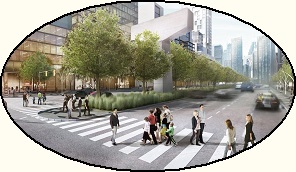Spadina Literary Review — edition 10 page 11
local scene
The 100-year decision
(the Gardiner debate)
by Ian Allaby
City Council in a marathon session in early June had to decide whether to take down the eastern end of the elevated Gardiner Expressway and replace it with a grand boulevard (the Boulevard Option) or keep the expressway up in modified form (the Hybrid Option).
Proponents of the Boulevard (the Boulevardiers, let’s call them for fun) took to calling this a 100-year decision, emphasizing that if the city chose the Hybrid, keeping the Gardiner up, it would be saddling future generations with an expensive eyesore.

The grand boulevard
After two days of debate, council, led by Mayor John Tory, chose the Hybrid. This decision defied the advice of city planners and entailed an extra cost of half a billion dollars compared to the Boulevard.
The news media, having cranked up the suspense for weeks, made out that the decision was a squeaker. But it wasn’t. Mayor Tory, exercising his privilege of putting the main motion, set it up so that the Boulevard would have to be voted before the Hybrid. The Boulevard was then defeated handily, 26-19. When the Hybrid came up, laden with a mess of amendments, some of which were bound to be a waste of staff time, it passed by the lesser margin of 24-21, which was the figure the press focused on.
Nor can it be said that the vote was exactly an urban-suburban split. (And I should explain that altho former Toronto and its former inner suburbs have been One Big City since Mike Harris imposed amalgamation in 1998, I’ll retain the term “suburb” here to describe those vast areas — Etobicoke, North York, and Scarboro — that remain mostly low-density and car-centric.) While the Boulevardiers included all the councillors of former Toronto along the waterfront and up to midtown level, they also included a smattering of North York and Scarboro councillors. And while the majority of suburban councillors were Hybrid proponents (Hybros, let’s call them), they had support from some councillors whose wards contain chunks of former Toronto north of St. Clair.
Still, the suburbs hold almost thrice the population of the old city of Toronto, so they can easily outvote it, which is a serious problem with the political structure of the One Big City. The downtown is everybody's affair, of course. It’s the historic kernel, the site of the foundation story, the centre of civic identity/gravity. It’s the locus of government, big business, big culture and big spectator sports. Plus, there’s a good chance it’s where the job is. A third of the city’s jobs are downtown, and over half of its GDP. It's the nucleus of the jurisdictional cell. But to what extent should the demands of the periphery govern the centre? To what degree should the daily obsessive drive to work determine the form of the urban core? It’s a question of balance, or in this case, imbalance.